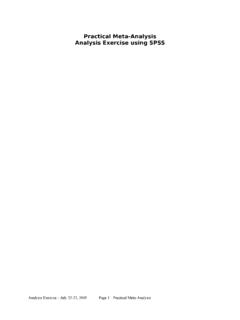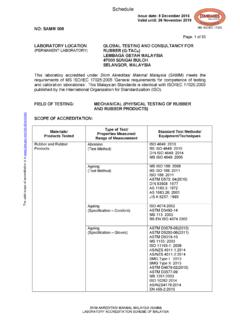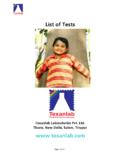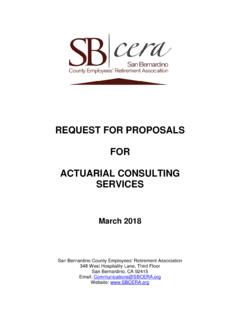Transcription of Purposes for Appraisal - PLANTanswers
1 EVALUATION OF TEXAS SHADE TREESAlan D. Dreesen Extension Forestry Specialist, The Texas A&M University SystemL-1683 Interest in the value and function of shade trees has grown in recent years. These treesperform several environmental functions and damage to them causes a monetary loss by theowner. The first formula for determining a dollar value of shade trees was proposed in the earlypart of the 20th Century by a professor at the University of Michigan as $5 compounded at 5%for 25 years. Several well-considered improvements were made over the years until a trunkformula method was presented to the National Shade Tree Conference [now International Societyof Arboriculture (ISA)] in 1949. Since then, several revisions have made the techniques forvaluing shade trees more acceptable to insurance companies, courts and the Internal RevenueService (IRS) . The latest version published by the ISA is the Guide for Plant Appraisal issued inDecember 1992.
2 The Texas Chapter of the ISA and the Texas Agricultural Extension Servicejoined to produce the "Texas Supplement to the Guide for Plant Appraisal : A FirstApproximation" in 1994. Methods of AppraisalThere are a number of methods used to arrive at the values of trees. Their particular uses varywith the size of tree, species, purpose , nature of loss, etc. The Guide for Plant Appraisal dealsseparately with the following:!Replacement Cost Method !Trunk Formula Method !Palms !Cost Repair !Cost of Cure !Crop Value !Forest Appraisal (Timber) The responsible appraiser should be able to support an Appraisal with documentation andevidence that would stand the test of court cross examination. He/she should be considered aplant expert who is familiar with the biological, as well as the economic, factors important inappraising the condition, species, measurements and location effects of particular plants. Plantappraisal may involve more than just trees; it often includes shrubs, vines, ground plants andlandscape for AppraisalTrees and other plants are often appraised for a variety of reasons including: insurance valuationor claims, wrongful loss, property value contribution, casualty loss for tax Purposes and using any method to arrive at a value anticipated as a casualty loss, be aware that losses fornon-business taxpayers must exceed 10 percent of the adjusted gross income in the year of theloss.
3 Therefore one may need a substantial loss to qualify. For more information on casualtylosses, see TAEX Fact Sheet "L-1516, Damage Recovery Opportunities for Loss of LandscapeTrees" and the IRS publication dealing with casualty losses. Replacement ValueThe value of shade trees in Texas usually can be determined by using the fair market value of areplacement tree (planted and guaranteed) from tree nurseries. If a species is not available from anursery and the tree is small, base the fair market value on that of a similar species of comparablesize. Large tree companies sell and plant trees up to 8 inches in diameter. The value of largertrees can be estimated using one of the other methods of Appraisal . The trunk formula methodusually underestimates the value of small trees, but is frequently used in estimating values oftrees larger than 8 inches in diameter measured at feet above the ground. The FormulaFour factors are considered in the formula: size, species, condition and location.
4 Size isaddressed later in this paper. Species ratings are regionalized for Texas in the "Texas Supplementto the Guide for Plant Appraisal " published by the Texas Chapter of the ISA in 1994. Copies maybe purchased from the Texas Chapter by writing it's Business Manager, Walterscheidt, 242 Monkey Road, Elgin, TX 78621. The cost is $ including shipping. Note. The ISA copyrighted the formula in the 1992 Guide for Plant Appraisal . Permission to useit in this publication was denied. Any one interested in obtaining a copy of the Guide may writethe ISA at Box 3129, Champaign, Illinois 61826-3129. SizeThe shade tree evaluation committee of the International Society of Arboriculture determinedthat the size of a tree's trunk expresses shade tree size. The American Nursery and LandscapeAssociation's (formerly the American Association of Nurserymen) approach in measuring treediameter is generally followed. For trees with a diameter 4-inches or smaller, the diameter isdetermined at a height of 6 inches above the ground.
5 For trees with a diameter of 5 to 8 inches,the diameter is determined 12 inches above the ground. For trees with diameters larger than 8inches, the diameter is determined at a height of feet. Exceptions to these rules occur wherelow branches cause trunk swell, in which case an evaluator would measure the diameter justabove the swollen area. For multi-trunked trees, full diameter of the largest trunk plus half thediameter of the other trunks determines the diameter for computing the cross section area whichis the number used for the size factor in the formula. The cross section area is determined by theformula where D equals the diameter measured. For example, a 10-inch Class 1 tree inperfect condition and location would be worth $1,964 (at $36 per square inch). = (10) = in222 in x ($36/in) = $2,82722 SpeciesNot all species and varieties of trees are of equal value. Permanence, maintenance needs,landscape quality and site adaptability influence the value of a species.
6 Grouping tree species intovalue classes is subjective and may vary from one part of the state and one tree specialist toanother. The following list can guide the appraiser who must also judge based on experience withthe species. Species value of trees not listed should be made by the specialist involved in theevaluation. AppraisersQualified appraisers may be found in most areas by checking with the Texas Chapter,International Society of Arboriculture , the Texas Society of American Foresters , Association ofConsulting Foresters, Texas Agricultural Extension Service , or Texas Forest Service . For timber appraisals (Forest Appraisals), it would be wise to retain a consulting professionalforester who has one or more degrees in forestry and is an independent consultant. Landscape plant consultants may be involved in the forestry, nursery and landscape, or relatedbusinesses. NOTES A new "Guidelines for Plant Appraisal " is due to be released in early 2000.
7 Ordering informationcan be obtained by calling the , the Texas Supplement to the Guide will be revised during 2000 and available in2001. Class 1--100 percent !Carya !Carya illinoensis--Pecan !Cornus florida--Flowering Dogwood!Diospyros texana--Texas Persimmon!Fagus grandifolia--American Beech !Ilex opaca--American Holly !Ilex vomitoria--Yaupon Holly !Juglans nigra--Black Walnut !Liquidambar stryraciflua--Sweetgum !Magnolia grandiflora--SouthernMagnolia !Magnolia virginiana--Sweetbay !Nyssa sylvatica--Tupelo !Picea pungens--Colorado Blue Spruce !Pinus edulis--Pinon Pine !Pinus ponderosa--Ponderosa Pine !Pinus taeda--Loblolly Pine !Pithecellobium flexicaule--Texas Ebony !Quercus alba--White Oak !Quercus falcata--Southern Red Oak !Quercus macrocarpa--Bur Oak !Quercus muhlenbergii--Chinkapin Oak !Quercus nigra--Water Oak !Quercus shumardii--Shumard Oak !Quercus texana--Spanish Oak !Quercus virginiana--Live Oak !Sophora secundiflora--Mescal BeanSophora !
8 Taxodium distichum--Baldcypress !Ulmus crassifolia--Cedar Elm Class 2--80 percent!Acer grandidentatum sinuosum--BigtoothMaple !Arbutus texana--Texas Madrone !Ehretia anacua--Anaqua !Fraxinus velutina (Select Male--VelvetAsh !Fraxinus velutina 'glabra'--Modesto Ash !Ginkgo biloba--Ginkgo !Gymnocladus dioicus--KentuckyCoffeetree!Koelreuteria bipinnata--Southern GoldenRaintree !Koelreuteria paniculata--PanicledGolden Rain tree !Lagerstroemia indica--Crepemyrtle !Liriodendron tulipifera--Tulip-poplar !Olea manzanilla--Manzanilla Olive !Pinus elliottii--Slash Pine !Pinus halepensis--Aleppo Pine !Pinus nigra--Austrian Pine !Pinus thunbergii--Japanese Black Pine !Pistacia chinensis--Chinese Pistachio !Pyrus calleryana--Callery Pear Cultivars !Quercus phellos--Willow Oak !Quercus stellata--Post Oak !Quercus velutina--Black Oak !Sophora japonica--Japanese Pogodatree !Ulmus americana--American Elm Class 3--60 percent!Acacia farmesiana--Huisache !Acer rubrum--Red maple !)
9 Betula nigra--River Birch !Broussonetia papyrifera--Paper Mulberry!Bumellia lanuginosa--Gum Elastic !Cedrus deodara--Deodar Cedar !Celtis occidentalis--Common Hackberry !Cercis canadensis--Redbud !Chilopsis linearis--Desert Willow !Cupressus arizonica--Arizona Cypress !Eriobotrya japonica--Loquat !Fraxinus pennsylvanicalanceolata--Green Ash !Fraxinus velutina (seedling)--ArizonaAsh !Gleditsia tracanthos inermis--ThornlessHoneylocust !Juniperus , Cedar !Leucaena pulverulenta--Great Lead-tree !Malus species and varieties--FloweringCrab Apples !Morus alba (fruitless)--FruitlessMulberry !Persea americana--Avocado !Persea borbonia--Redbay !Pinus echinata--Shortleaf Pine !Pinus pinea--Italian Stone Pine !Platanus occidentalis--AmericanPlanetree, Sycamore !Prosopis glandulosa--Honey Mesquite !Prunus mexicana--Mexican Plum !Sabium sebiferum--Chinese Tallowtree !Sapindus drummondii--WesternSoapberry !Ulmus parcifolia--Chinese Elm !Ulmus parcifoliasempervirens--Evergreen ElmClass 4--10 percent!
10 Acer negundo--Boxelder !Acer saccharinum--Silver Maple !Ailanthus altissima--Tree of Heaven !Albizia julibrissin--Silktree !Catalpa !Celtis laevigata--Sugarberry !Cratcegus !Eleagnus angustifolius--Russian Olive !Firmiana simplex--Chinese Parasol Tree !Maclura pomifera--Bois d'Arc !Melia azedarach--Chinaberry !Morus rubra--Red Mulberry !Parkinsonia aculeata--Palo Verde !Populus and Poplars !Prunus blireiana--Ornamental Plum !Robinia pseudoacacia--Black Locust!Salix !Tamarix spp--Tamarisk !Thuda !Ulmus pumila--Siberian Elm !Ziyphus jujube--Jujube ConditionFew shade trees are perfect. As trees become large and old, they offer become defective through decay,broken limbs, damage by humans or uneven growth. The specialist appraising the tree must judge thecondition on a percentage basis. For example, a 10-inch tree in Class 1 might be poorly proportioned ordisplay symptoms of heart rot. Instead of being worth $1,964, it would be appraised at 60 percent or$1,178.






